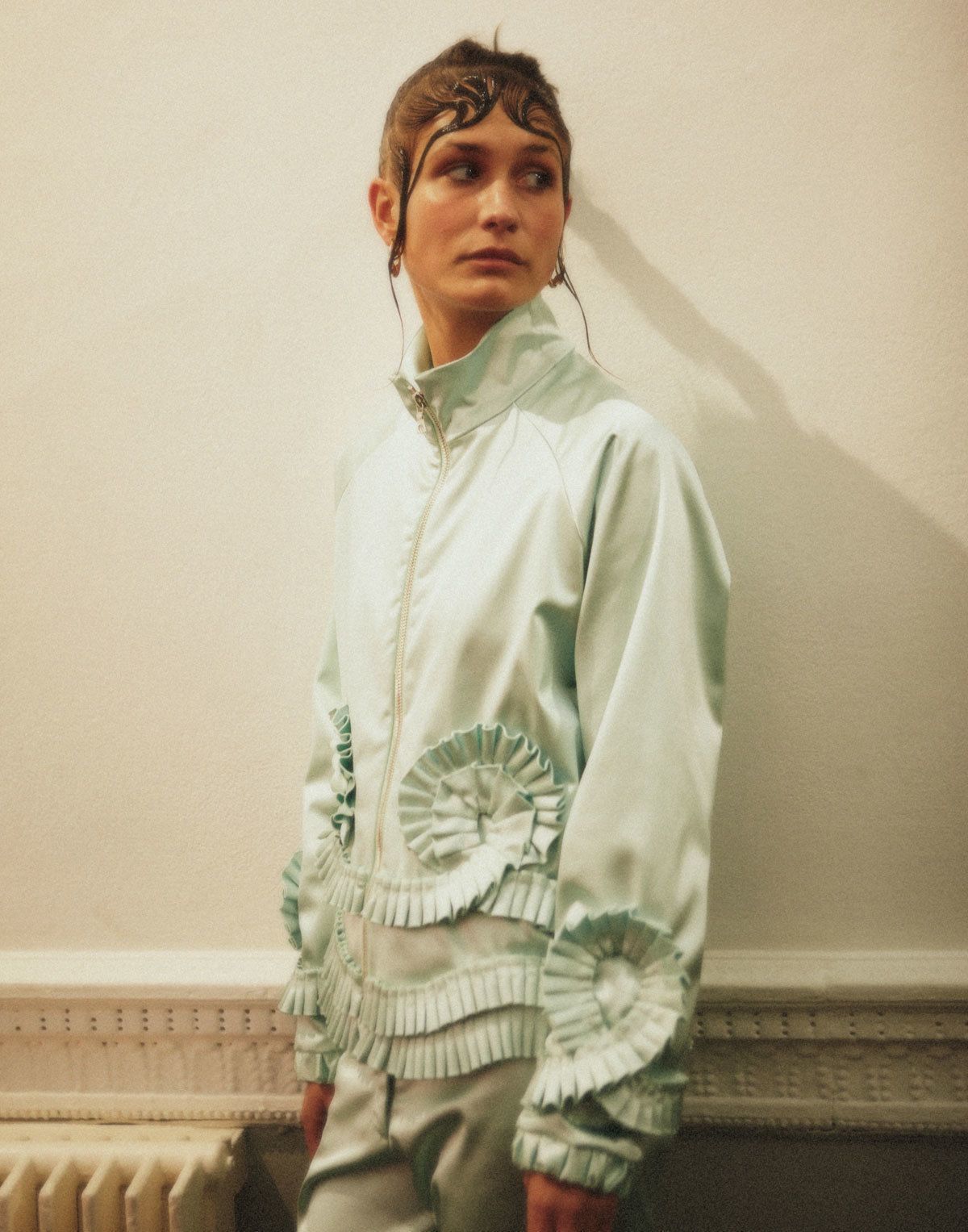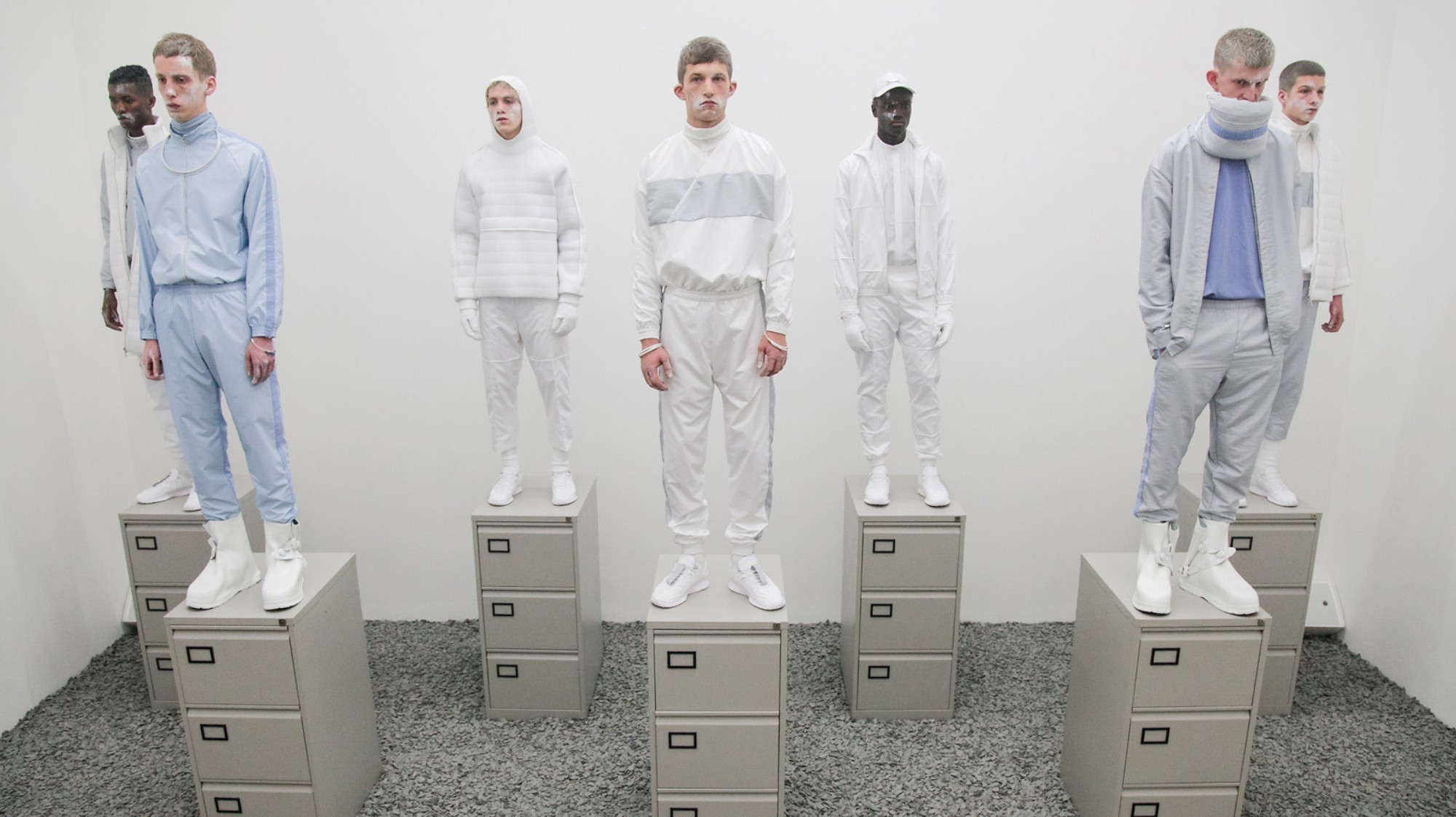The tracksuit was fall/winter 15’s standout statement in an otherwise 70s sea of fringing and flares. At Nico Panda, Nicola Formichetti re-imagined it in eye-watering, scarlet mottled jerseys with emblazoned slogans; Caitlin Price’s alcopop satin trackies were a blend of courtly couture meets underage disco parking lot-chic; Ed Marler sent models out in laced-up, sexed-up, barely-there two piece leisure wear, wrapped in sheepskins that would make Del Boy blush. Tracksuits for boys isn’t news. When Skepta first walked for Nasir Mazhar back in 2014 in a full black tracksuit with in-built balaclava, he was simply confirming Nasir’s status as the ultimate FUBU, anti-concept designer. The message? For men, sportswear, tracksuits, casual design; it’s always been there on the streets. Another of the UK’s most feted menswear designers are the Cottweiler boys who have been pivotal in the re-emergence of hi-tech performance-sportswear as acceptable daywear for the office worker. Their tracksuits are made unisex by the clever removal of shoulder seams and subtle introduction of drawstrings. FKA Twigs is a fan.
The tracksuit first left the running track and hit the street-corner in the mid-70s. The original cotton models were intended for the practical use of keeping athletes warm while training. They were, and still are, worn over kit whilst in transit or taking a breather. Things pretty much stayed that way until the shell suit appeared in early 80s New York on the backs of hip hop stars and break dancers who were being influenced by the nascent wave of African-American celebrity jocks. Super stars like Michael Jordan and OJ Simpson caught the world’s attention and overnight sportswear became street wear and was suddenly an expression of elevation and distinction that was both practical and neighborhood-ostentatious. It’s hard to conceive the radical impact of Run DMC when they proudly recast the template for street wear in the US and replaced the zoot suit and furs for an altogether sportier look, which fast became the style of young black America.
When the tracksuit hit the streets of the UK in the 70s it didn’t achieve the enduring cachet of the Clarks Desert Boot or the military surplus parka; it remained doggedly undesirable – something your mum might wear to her step class or your granddad to the bookies. Then Acid House hit and tracksuit bottoms became mandatory get-up. During the Brit Pop ascendancy, the adidas Firebird top (like the leotard in the 70s, which moved from the aerobics class attire to Studio 54 de rigueur) became club-clobber. Fast-forward to the 90s and mainstream British musicians took up the torch; Jamaroquai and Mel C, anyone?

Fashion East designer Caitlin Price’s tracksuits, despite their future-leaning fabrications, are reminiscent of the early 00s UKG era, when Gucci horsebit loafers were obligatory and queuing for Gas on a Saturday was a thing. “I remember my grandma taking my sister and me shopping for clothes,” she explains, “clothes my mum wouldn’t buy for us. I wanted a pearlescent shell suit but she would only buy me a navy and yellow nylon Kappa tracksuit. I wore it to death. I feel far more comfortable in trainers and trousers than I do in a dress and heels… I can’t take myself seriously in heels.”
Off the catwalk it’s a different story. The tracksuit has become regarded as a uniform of the disenfranchised and excluded, and as such, has become stigmatized. The matching two-piece became a signifier of anti-social behavior – the hallmark of the slovenly, the ‘n.e.e.t’. and the pink velour of Vicky Pollard. In 2005, the hoodie was officially banned by Bluewater Shopping Centre in Kent and later by several schools in England and Wales, and Anti-Social Behavior Orders (Asbos) became inseparable from the image of the hooded-youth gone feral on estates. A simple clothing choice was effectively demonized. In 2012 a neighborhood security guard in Florida gunned down 17-year-old student Trayvon Martin because his suspicion had been irrationally aroused by the young man’s top. Protestors donned hoodies as an expression of solidarity in the weeks following Trayvon’s death.
Despite the bad rap, or maybe because of it, the tracksuit has made a comeback. In 2015 the full tracksuit has become the ultimate mod uniform: hi-tech, practical, comfortable and this time round, unisex. The season’s clamor for the reinvention is in part down to the tracksuit’s appeal in a post-modern world where no real subcultures survive. It’s identity dressing; you blend in but you stand out, it’s smart but not formal, discreet but spirited. In the words of Skepta; “went to the show, sitting front row in a black tracksuit and it’s shut down.”
Credits
Text Nellie Eden
